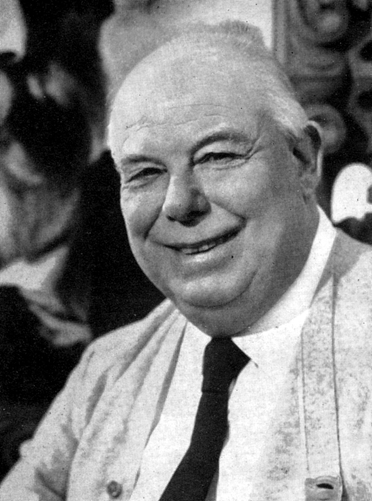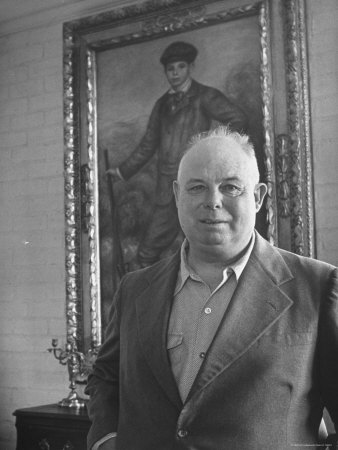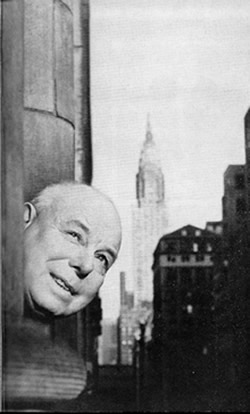<Back to Index>
- Director Jean Renoir, 1894
PAGE SPONSOR



Jean Renoir (15 September 1894 – 12 February 1979) was a French film director, screenwriter, actor, producer and author. As a film director and actor, he made more than forty films from the silent era to the end of the 1960s. His pictures Grand Illusion (1937) and The Rules of the Game (1939) are often cited by critics as among the greatest films of all time. As an author, he wrote the definitive biography of his father, the painter, Pierre - Auguste Renoir, Renoir, My Father (1962).
Renoir was born in the Montmartre district of Paris, France. He was the second son of Aline Charigot and the French painter Pierre - Auguste Renoir. He was also the brother of Pierre Renoir, a noted French stage and film actor; the uncle of Claude Renoir, a cinematographer; and the father of Alain Renoir, late professor emeritus of comparative literature at the University of California at Berkeley.
As a child, Renoir moved with his family to the south of France. He and the rest of the Renoir family were the subjects of many of his father's paintings. His father's financial success ensured that the young Renoir was educated at fashionable boarding schools, which, as he later wrote, he continually ran away from.
At the outbreak of World War I Renoir was serving in the French cavalry. Later, after receiving a bullet in his leg, he served as a reconnaissance pilot. His leg injury left him with a permanent limp, but allowed him to discover the cinema, where he used to recuperate with his leg elevated while watching the films of Charlie Chaplin and others. After the war, Renoir followed his father's suggestion and tried his hand at making ceramics, but he soon set that aside to make films, inspired, in particular, by Erich von Stroheim's work.
In 1924, Renoir directed the first of his nine silent films, most of
which starred his first wife, who was also his father's last model, Catherine Hessling.
At this stage his films did not produce a return, and Renoir gradually
sold paintings inherited from his father to finance them.
During the 1930s Renoir enjoyed great success as a filmmaker. In 1931 he directed his first sound films, On purge bébé (Baby's Laxative) and La Chienne (The Bitch). The following year he made Boudu Saved From Drowning (Boudu sauvé des eaux), a farcical sendup of the pretensions of a middle class bookseller and his family, who meet with comic, and ultimately disastrous, results when they attempt to reform a vagrant played by Michel Simon.
By the middle of the decade Renoir was associated with the Popular Front, and several of his films, such as The Crime of Monsieur Lange (Le Crime de Monsieur Lange, 1935), Life Belongs to Us (1936) and La Marseillaise (1938), reflect the movement's politics.
In 1937 he made one of his best known films, Grand Illusion (La Grande Illusion), starring Erich von Stroheim and Jean Gabin. A film on the theme of brotherhood about a series of escape attempts by French POWs during World War I, it was enormously successful but was also banned in Germany, and later in Italy after having won the "Best Artistic Ensemble" award at the Venice Film Festival. It was the first foreign language film to receive a nomination for the Academy Award for Best Picture. This was followed by another cinematic success: The Human Beast (La Bête Humaine) (1938), a film noir tragedy based on the novel by Émile Zola and starring Simone Simon and Jean Gabin.
In 1939, now able to co-finance his own films, Renoir made The Rules of the Game (La Règle du Jeu), a satire on contemporary French society with an ensemble cast. Renoir himself played the character Octave, a sort of master of ceremonies in the film. The film was met with derision by Parisian audiences upon its premiere and was extensively reedited, but without success. It was his greatest commercial failure.
A few weeks after the outbreak of World War II, the film was banned.
The ban was lifted briefly in 1940, but after the fall of France it was
banned again. Subsequently the original negative of the film was destroyed in an Allied bombing raid.
It was not until the 1950s that French film enthusiasts Jean Gaborit
and Jacques Durand, with Renoir's cooperation, were able to reconstruct a
near complete print of the film. Today The Rules of the Game appears frequently near the top of critics' polls of the best films ever made.
A week after the disastrous premiere of The Rules of the Game, in July 1939, Renoir went to Rome with Karl Koch and Dido Freire, subsequently his second wife, to work on the script for a film version of Tosca. This he abandoned to return to France in August 1939, to make himself available for military service. At the age of 45, he became a lieutenant in the French Army Film Service, and was sent back to Italy, to teach film at the Centro Sperimentale di Cinematografia in Rome, and resume work on Tosca. The French government hoped this cultural exchange would help maintain friendly relations with Italy, which had not yet entered the war. As war approached, however, he returned to France and then, after Germany invaded France in May 1940, he fled to the United States with Dido.
In Hollywood, Renoir had difficulty finding projects that suited him. In 1943, he co-produced and directed an anti - Nazi film set in France, This Land Is Mine, starring Maureen O'Hara and Charles Laughton. Two years later, he made The Southerner, a film about Texas sharecroppers that is often regarded as his best work in America and one for which he was nominated for an Academy Award for Directing.
In 1945 he made Diary of a Chambermaid, an adaptation of the Octave Mirbeau novel, Le Journal d'une femme de chambre, starring Paulette Goddard and Burgess Meredith. The Woman on the Beach (1947) starring Joan Bennett and Robert Ryan was heavily reshot and reedited after it fared poorly among preview audiences in California. Both films were poorly received and were the last films Renoir made in America. At this time, Renoir became a naturalized citizen of the United States.
In 1949 Renoir traveled to India and made The River, his first color film. Based on the novel of the same name by Rumer Godden, the film is both a meditation on human beings' relationship with nature and a coming of age story of three young girls in colonial India. The film won the International Prize at the Venice Film Festival in 1951.
After returning to work in Europe, Renoir made a trilogy of Technicolor musical comedies on the subjects of theater, politics and commerce: Le Carrosse d'or (The Golden Coach) (1953) with Anna Magnani, French Cancan with Jean Gabin and María Félix (1955) and Eléna et les hommes (Elena and Her Men) with Ingrid Bergman and Jean Marais (1956). During the same period, Renoir produced in Paris the Clifford Odets play, The Big Knife, and wrote and produced in Paris for Leslie Caron his own play, Orvet.
Renoir's next films were made in 1959 using techniques Renoir adapted from live television at the time. Le Déjeuner sur l'herbe (Picnic on the Grass), starring Paul Meurisse and Catherine Rouvel, was filmed on the grounds of Pierre - Auguste Renoir's home in Cagnes - sur - Mer, and Le Testament du docteur Cordelier (The Testament of Doctor Cordelier), starring Jean - Louis Barrault, was made in the streets of Paris and its suburbs.
In 1962 Renoir made what was to be his penultimate film, Le Caporal épinglé (The Elusive Corporal) with Jean - Pierre Cassel and Claude Brasseur. Set among French POWs during their internment in labor camps by the Nazis during World War II, the film explores the twin human needs for freedom, on the one hand, and emotional and economic security, on the other.
In 1962, Renoir published a loving memoir of his father, Renoir, My Father, in which he described the profound influence his father had on him and his work. As funds for his film projects were becoming harder to obtain, Renoir continued to write screenplays and then wrote a novel, The Notebooks of Captain Georges, published in 1966. Captain Georges is the nostalgic account of a wealthy young man's sentimental education and love for a peasant girl, a theme also explored earlier in his films Diary of a Chambermaid and Picnic on the Grass.
Renoir made his last film in 1969, Le Petit théâtre de Jean Renoir (The Little Theatre of Jean Renoir). The film is a series of four short films made in a variety of styles and is, in many ways, one of his most challenging, avant - garde and unconventional works.
Thereafter, unable to find financing for his films and in declining health, Renoir spent the last years of his life receiving friends at his home in Beverly Hills and writing novels and his memoirs.
In 1973 Renoir was preparing a production of his stage play Carola with Leslie Caron and Mel Ferrer when he fell ill and was unable to direct. The producer Norman Lloyd, a friend and actor in The Southerner, took over the direction of the play, which was broadcast in the series program Hollywood Television Theater on WNET, Channel 13, New York on February 3, 1973.
In his memoirs My Life and My Films (1974) Renoir wrote of the influence exercised upon him by his cousin, Gabrielle Renard, the woman seen in a portrait by his father. Shortly before his birth, she came to live with the Renoir family, and helped raise the young boy. She introduced him to the Guignol puppet shows in the Montmartre of his childhood: "She taught me to see the face behind the mask and the fraud behind the flourishes", he wrote. "She taught me to detest the cliché." He concluded his memoirs with the words he had often spoken as a child, "Wait for me, Gabrielle."
In 1975 he received a lifetime Academy Award for his contribution to the motion picture industry and that same year a retrospective of his work was shown at the National Film Theatre in London. Also in 1975, the government of France elevated him to the rank of commander in the Légion d'honneur.
Jean Renoir died in Beverly Hills, California on February 12, 1979. His body was returned to France and buried beside his family in the cemetery at Essoyes, Aube, France.
On his death, fellow director and friend Orson Welles wrote an article for the Los Angeles Times, "Jean Renoir: The Greatest of all Directors".
Jean Renoir has a star on the Hollywood Walk of Fame at 6212 Hollywood Blvd. Several of his ceramics were collected by Albert Barnes and can be found on display beneath his father's paintings at the Barnes Foundation in Merion, Pennsylvania.